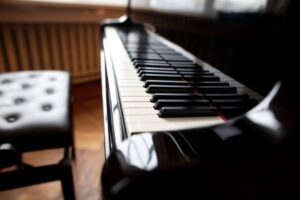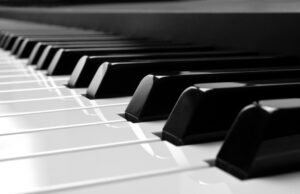 At first glance, a piano simply looks like a bunch of black and white keys attached to a box in that instantly recognizable harp shape. You may be surprised to hear that a grand piano contains about 12,000 parts in total! That may sound overwhelming at first, however, most of those parts work together and do not need to be managed individually. If you are interested in or already taking piano lessons in Orlando, it’s a good idea to become acquainted with the inner workings of a piano so that you have a deeper insight into the music you’re playing. Unless you are interested in building your own piano, you probably don’t need to know all 12,000 pieces, so here are the most important parts that give the piano that iconic look and sound.
At first glance, a piano simply looks like a bunch of black and white keys attached to a box in that instantly recognizable harp shape. You may be surprised to hear that a grand piano contains about 12,000 parts in total! That may sound overwhelming at first, however, most of those parts work together and do not need to be managed individually. If you are interested in or already taking piano lessons in Orlando, it’s a good idea to become acquainted with the inner workings of a piano so that you have a deeper insight into the music you’re playing. Unless you are interested in building your own piano, you probably don’t need to know all 12,000 pieces, so here are the most important parts that give the piano that iconic look and sound.
Keys
A piano consists of 88 keys: 52 white and 36 black. The white keys are called naturals and black keys are accidentals, also known as sharps and flats. The keys on the left side of the piano play the lowest notes and the keys on the right play the highest. Because the keys don’t require too much technique to make a decent sound (curved fingers and relaxed wrists), the piano is a great instrument to start learning with an Orlando piano teacher at any age.
Hammers and strings
Once a key is pushed down, the piano turns into a bit of a Rube Goldberg machine. Each key is attached to a felt covered hammer that, when pressed, causes the hammer to strike the strings. Depending on how hard a key is pressed, the hammer can hit the strings gently to create a soft sound or hard to make a loud sound. For the lowest notes on the piano, the hammers will hit one, thick string that is tuned to a specific pitch. As the notes get higher, each key has 2 or 3 strings that are struck by the hammers. This creates a much more resonant and full sound. Think of someone playing an instrument or singing by themselves versus a group of people. Even though the strings under each hammer are tuned to the same pitch, they make a richer tone working together.
Case and Lid
The case of a piano is the largest component of the instrument and houses most of the instruments’ parts. In a baby or grand piano the case has a beautiful harp shape. In an upright piano the case is much shorter and square, causing the sound to lose some of its luster. The lid covers the case and can be opened different amounts on a baby and grand piano to change how much the instrument resonates. If you haven’t looked inside of a piano, I strongly suggest it! It is amazing to see all of the inner workings, especially while being played.
Pedals
Acoustic pianos have two or three pedals that hang below the keys near a players’ feet. One of the things you need to know about using the pedals is that the pedal on the left is called an una corda, or soft pedal. When pressed, this shifts the keys and hammers slightly to the right so that the hammers will hit fewer strings and create a softer sound. The middle pedal is the least common of the three and is called the sostenuto pedal. This allows you to play some notes long and others short at the same time. The right pedal is the damper. This pedal is the first one you will use as a student and causes the notes to ring much longer. Although a lot of electronic keyboards do not have any pedals, many come with a damper pedal attachment.
Teachers at Lessons In Your Home provide students with exercises and techniques that they can implement in their spare time to speed up their learning. They can either come to your home to teach or can also provide online music lessons. Our virtual music lessons are taught by local music teachers who plan their lessons to suit your child. Contact us today to find an instructor near you who will help your child master their skills.
By Tracy Gibler
